Aviation Management - Introduction
Aviation industry is the business sector that manufactures, maintains, and operates the aircrafts and the airports. When it comes to aviation, there is a broad range of responsibilities within. It comprises activities at the airport as well as in the aircraft. It involves ground duties that are required to perform before the flight takes off, the activities during the flight, and the activities after it lands.
What is Aviation?
The term aviation, was coined by a French pioneer named Guillaume Joseph Gabriel de La Landelle in 1863. It originates from the Latin word avis that literally means bird. Aviation means all the activities related to flying the aircraft.
What is Aviation Management?
Aviation management involves managing the workflow of airline, airport, or other businesses pertaining to aviation or aerospace industry by carrying out the day-to-day operations of an airport or an airline.
A Brief History of Aviation
The original idea of kite-flying from China was the first attempt of humankind to fly some man-made object high into the air. Chinese used kites to send messages, lift humans, measure distances, and test winds during the 5thCentury to the 7th Century AD. They also prepared Hot Air Balloons to scare away enemies in the 3rd Century BC. Later during the period of Renaissance, Leonardo Da Vinci studied the flying principles of birds and anticipated that the equal amount of resistance is offered by an object to the air, just as the resistance air offers to the object.

During the 17th century, the then experts tried to create copper spheres containing vacuum and lift an airship as they knew by then that the objects lighter than the air can remain up in the air. During the 18th Century, they conducted five flights using balloon successfully in France. In 1647, the Polish King Władysław-IV invited the Italian inventor, Tito Livio Burattini to his court in Warsaw and built a model aircraft with four fixed glider wings. The aircraft had successfully lifted a cat with minor injuries while landing.
During the 19th and the 20th centuries, the experts around the world experimented continuously and came up with improved flying machines or aircrafts, which were heavier than air and based on the principles of aerodynamics. Most notable names are the Wright Brothers — Orville and Wilbur Wright. According to the Smithsonian Institution and Federation Aéronautique Internationale (FAI), the Wright brothers made the first sustained, controlled, powered, and heavier-than-air fight at Kill Devil Hills, North Carolina on December 17, 1903. Orville Wright took the first flight at 120ft high for 12 seconds.
Major Regulating Bodies in Indian Aviation Industry
The Ministry of Civil Aviation (MoCA) of Government of India is responsible to formulate policies and programs to develop and regulate civil aviation, and to implement the schemes for expanding civil air transport. It also oversees airport facilities, air traffic services, and air carriage of passengers and goods.
An Indian regulatory body for civil aviation named The Directorate General of Civil Aviation (DGCA) is under the MoCA. This directorate investigates aviation accidents and incidents.
Important Factors Driving Civil Aviation
The following are some most important factors that drive civil aviation −
- The Low Cost Carriers (LCCs), modern airports
- Emphasis on regional connectivity
- Foreign Direct Investment (FDI) in domestic airlines
- Advanced information technology (IT) interventions
In May 2016, domestic air passenger traffic rose 21.63 per cent from 7.13 million to 8.67 million as compared to the traffic in May, 2015. In March 2016, total number of flights at all Indian airports are recorded as 160,830; which is 14.9 per cent higher than the flights of March 2015.
According to the reports of the Centre for Asia Pacific Aviation (CAPA), by FY2017, Indian domestic air traffic is expected to cross 100 million passengers compared to 81 million passengers in 2015. According to CRISIL’s reports, the airlines of India are expected to record a collective profit of INR 8,100 crore (US$ 1.29 billion) in year 2016.
Aircraft Manufacturing Giants
Hindustan Aeronautics Limited (HAL), a government-owned corporation based at Bangalore, Karnataka, is an Indian giant that is governed by Ministry of Defence (MoD). It is involved in manufacturing and assembly of aircraft, navigation, and allied communication equipment. It also governs airports operations.
HAL works in collaboration with numerous international aerospace agencies such as Airbus, Boeing, Sukhoi Aviation Corporation, Israel Aircraft Industries, RSK MiG, RollsRoyce, Dassault Aviation, Indian Aeronautical Development Agency, and the Indian Space Research Organization (ISRO).
Aviation Management - IT
Aviation is a field that undergoes frequent changes. This industry works 24x7 hence, there is a change in manpower, resources, and the aircrafts too. The information technology is playing an instrumental role in the success of aviation. Right from the simulation software the trainee pilots use, here are some of the various software used by the staff of the aviation industry −
- Aircraft Maintenance Software that keeps tracks of on the floor activities of maintenance.
- Fuel Management Software that optimizes fuel procurement and reacts to the fluctuations in fuel price.
- Network and Route Performance Management Software that anticipates profitable air routes and enables quick decision-making.
- Catering Procurement Software that helps to carry out the entire procure-topay procedure seamlessly.
- Catering Production Software that emphasizes minimum waste and maximum customer satisfaction.
- Flight Information Display System (FIDS) at the airports works round the clock in real time to display the detailed flights status such that the travelers can get to know the latest information from any corner of the airport as well as on the Internet.
- Departure Control System (DCS) works in conjunction with the reservation system to keep the track of check-in travelers and issues boarding passes.
There are numerous mobile apps the customers use for checking flight times, booking flights, redeeming points against fare, and mobile checking-in. Thus, IT plays an important role in ensuring the smooth functioning of aviation operations.
Terms Used in Aviation
The following table provides a list of the most frequently used terms in Aviation Management −
| S.No | Term & Meaning |
|---|---|
| 1 |
AAI
Airport Authority of India. Equivalent FAA in US and CAA in UK.
|
| 2 |
Airport
A place where aircrafts take-off, land, and are maintained with facilities for passengers.
|
| 3 |
Aerodrome
An area of land or water; including buildings, installations and equipment designated, wholly or partially for the arrival, movement, or departure of aircrafts.
|
| 4 |
Airspace
The air available for the aircraft to fly in over a country or a sea.
|
| 5 |
Airliner
Any aircraft type which was designed and built specifically for airline use or which has entered service with airlines in significant numbers.
|
| 6 |
ANSP
Air Navigation Service Provider. A legal public or private entity that provides navigation services.
|
| 7 |
Prohibited area
An area within the territory specified by the Authority where flying is prohibited.
|
| 8 |
Restricted area
An area within the territory specified by the Authority where flying is subject to certain restrictions.
|
| 9 |
Dangerous area
An area within the territory specified by the Authority where activities dangerous to aviation may exist at specified times.
|
| 10 |
A codeshare agreement
It is an aviation business arrangement where two or more airlines share the same flight.
|
| 11 |
The airport ramp or apron
It is a part of an airport where aircrafts are parked, unloaded or loaded, refueled, or boarded. The use of the apron is covered by regulations, such as lighting on vehicles.
|
| 12 |
Aircraft Cabin
It is that section of the aircraft where passengers are seated.
|
| 13 |
IATA
International Air Transport Association. It is a trade association for the world’s airlines, representing about 260+ airlines and 83% of the total air traffic. It supports many areas of aviation activity and helps to form policies on critical aviation issues.
|
| 14 |
RESA
Runway End Safety Areas.
|
| 15 |
Runway
There are three types of runways — Parallel, Near-Parallel, and Intersecting.
|
| 16 |
Runway incursion or Runway excursion
A runway incursion is an incident where an unauthorized aircraft, a vehicle, or a person is on a runway. A runway excursion is overrun of an aircraft from the runway.
|
| 17 |
Slot
It is a pre-agreed time for a takeoff or landing to take place at a particular airport.
|
| 18 |
NLA
New Large Aircraft
|
| 19 |
Airline Hub
It is an airport that serves as a central connecting point through which many flights of a particular airline are routed.
|
| 20 |
Airfield
It is an area of land set aside for the take-off, landing, and maintenance of aircraft.
|
| 21 |
Terminal
It is a place at the airport from where a traveler boards the aircraft for journey.
|
| 22 |
ICAO
International Civil Aviation Organization. It is a UN-specialized agency established by United States to manage the administration and governance of the Convention on International Civil Aviation (Chicago Convention).
|
| 23 |
Aircraft Movement
Take-off or landing of an aircraft.
|
Aviation Management - Airline
Airline includes its equipment, routes, operating personnel, and their management. Airline provides a regular service of air transport on various routes. It is responsible for booking the tickets for the prospective passengers, taking care of the passengers and their luggage during transit, and transporting them safely to their destination. As the types of duties required to be done are multifold, the airline business is always working round the clock.
What is an Airline?
An organization that owns and operates many aircrafts, which are used for carrying passengers and cargo to different places.
The world’s first airline named DELAG established on 16th November, 1909. An airline business can be of various sizes and the ownership also varies. For example, it can be privately owned, jointly owned, or publicly owned. It also can be as small as a Domestic or as large as an International airline.
Major Airlines in India
The following are the major Indian airline players in the aviation industry −
- Public Sector Units (PSUs) − Air India and Pawan Hans.
- Airlines listed on stock exchange − SpiceJet, IndiGo, and Jet Airways.
- Private Airlines − GoAir, Air Asia, Vistara
Types of Carriers
There are two types of airline carriers −
- Low Cost Carrier (LCC)
- Full Service Carrier
Comparison between Low Cost and Full Service Carriers
The following table lists out the differences and similarities between the two carriers −
| Factor | Low Cost Carrier | Full Service Carrier |
|---|---|---|
| Operating Model | Same | Same |
| Fare Rates | Lower | Higher |
| On Board Services | Minimal. Customers are required to pay for food, drinks, or other consumable stuff. | Full service is given to the customer. Food is not on sale but the ticket price is inclusive of the price for food. |
A low-cost carrier is an airline that offers lower fares and fewer comforts. These airlines are budget airlines. They make up for the loss borne in the ticket fare by offering food or priority boarding on sale. All low-cost carriers reduce cost on comforts and services. Their fares are always lesser than the fares offered by their legacy counterparts. LCCs target urgent travelers and Budget travelers who are mostly price-concerned.
Organizational Structure of an Airline
Airline, as any other business calls for teamwork from its personnel. As we see in the diagram given below, there are various responsibilities the airline staff needs to carry out and the structure is indeed like that of a big elephant.
Cockpit Positions in Flight
The personnel working in the cockpit or flight deck are −
- Pilot − The highest ranking member of the aircrew, designated as Pilot-inCommand.
- First Officer − He is a pilot who is not the chief pilot.
- Second Officer − He works as a relief pilot and also performs selected duties.
- Flight Engineer − He is responsible for flight systems and fuel. Today, the position is diminished and his position is typically crewed by a dual-licensed Pilot and Flight Engineer.
- Airborne Sensor Operator − He gathers information from airborne platforms.
Today, the duties of the Flight Navigator and the Radio Operator are performed by Captain or FO of the flight under dual licensing due to the aid of modern-age navigation and radio systems.
Cabin Positions in Flight
The personnel working in the cabin are −
- In-Flight Service Manager − This manager is a team lead of the rest of the cabin crew.
- Flight Attendant − They are responsible for assisting the passengers and their safety.
- Flight Medic − A para-medic officer employed on flying ambulance.
- Loadmaster − For cargo aircrafts, he is responsible to load the goods and check the weight and balance before and after the loading.
Let us see the organizational structure of an Airline −
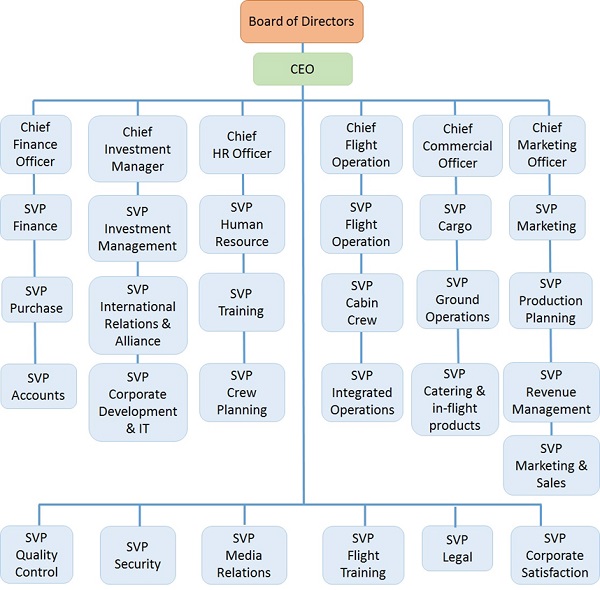
Note − SVP = Senior Vice President.
What is AAI in Indian Aviation?
The Airport Authority of India (AAI) is a public authority that provides Air Navigation Service (ANS) at the airports. It works under the Ministry of Civil Aviation (MoCA) to build, upgrade, maintain, and manage civil aviation infrastructure in India.
The Indian government formed this organization in April 1995 by merging two organizations: One, International Airports Authority of India (IAAI) that was founded in 1972 to manage the nation's international airports and two, the National Airports Authority (NAA) that was formed in 1986 to look after domestic airports.
Major Roles of AAI
The major roles of AAI include −
- To provide communication, navigation, and surveillance systems (CNS).
- To provide Air Traffic Management (ATM) service in Indian airspace and adjoining oceans.
- To manage all the Indian airports.
- To ensure the safety of the airports and aircrafts.
- To provide calibration of navigational aids in the flights of Indian Air Force, Indian Navy, Indian Coast Guard, and private airfields in India.
- To provide passenger facilities and information system at the passenger terminals at airports.
Handling the Passengers
The passengers are at the disposal of the airline right from when they enter into the airport for departure till they arrive at the destination airport. Airlines use Passenger Service System (PSS) or Passenger Management Systems (PMS) to handle the passengers. It assists the personnel to handle passengers of different requirements.
Handling Unaccompanied Child Passengers
The unaccompanied children aged between 5 to 12 years are allowed on flight. The children below 5 years are allowed when they are with an adult. An unaccompanied child is seated near crew area and is always supervised by the airline staff from the departure airport to the destination airport till the time he/she is handed over to the responsible relative of the child.
Handling Passengers with Special Needs
Disables passengers, passengers with reduced mobility, aged passengers, passengers with visual or hearing impairment, and pregnant women are handled with special care. The passengers need to request the airline for assistance 48 hours before departure. The airlines provide it free of charge.
Passengers are given directions for safe journey once they board the aircraft.
Luggage Handling
Let us discuss luggage handling. To begin with, there are three types of baggage −
- Crew baggage − It is identified with a crew label showing all flight details.
- Cabin baggage of passengers − It is checked under the scanner for hazardous, liquid, or any other kind of unpermitted articles. On clearance, it is allowed to be taken into the cabin. It must be small in size and weighing up to 6kg.
- Check-in baggage of passengers − It is checked-in to be kept into the aircraft’s baggage storage area.
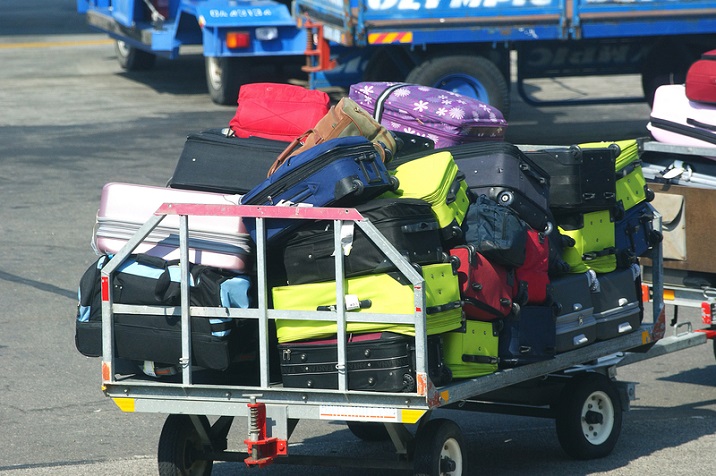
There is a systematic way of how to handle passenger baggage. The checked baggage handling is carried out in three stages −
- Move bags from the check-in area to the departure area.
- Move bags from one departure area to another during transfers.
- Move bags from the arrival area to the baggage-claim area.
The following are the steps of baggage handling −
Step 1 − The airline authorities check the baggage under scanner once the passenger arrives at the airport. It is checked for the presence of any explosives or hazardous items, which are not permitted to carry.
Step 2 − If there are no such items, the passenger proceeds to baggage drop-off counter of the airline.
Step 3 − The staff weighs the baggage. If it is excess baggage, the staff requests the passenger to pay for it and enters the baggage details into the system.
Step 4 − The staff then pastes the claim tag on the baggage and gives a copy of it to the passenger.
Step 5 − The baggage goes on the conveyer belt to the airline baggage handling staff. It is then loaded into the trollies to be taken to the aircraft.
Step 6 − The baggage is loaded into the aircraft.
Step 7 − At the arrival airport, the trollies approach the aircraft on its arrival.
Step 8 − The crew member informs on which conveyer belt the luggage of that specific aircraft would be placed.

Step 9 − The system database is updated by barcode reading and airline luggage handling staff places the luggage on the predetermined conveyer belt.
Step 10 − The luggage reunites with the respective passengers.
It is not always this straight. There are times when the luggage is found suspicious at the departure airport, then the passenger is requested to open the baggage. The airline baggage handling staff also needs to handle lost baggage complaints efficiently.
Handling the Aircraft on Ground
It is the period starting from the aircraft arrival to its departure again. When the aircraft is parked at an airport, it is prepared for the next departure. Here are some basic duties carried out when the aircraft is parked on the airport −
Catering Duties
- Removing empty cans and containers, old newspapers and magazines, and soiled blankets and pillows.
- Replenishing fresh food and drinks, and other consumables such as soaps, tissues, toilet papers.
- Lavatory drainage.
Ramp Duties
- Guiding the aircraft into and out of the parking position.
- Towing the aircraft by push-back trucks.
- Water and Fuel refilling.
The majority of the airlines outsource aircraft ground handling to the service providers.
Airline - Financial Management
Airline financial management is a multifaceted challenging task. Most of the airlines rely on the conventional MS Excel to generate various financial statements. Selecting and implementing the right solution for cash management is the key challenge the airlines often face. Today, many airlines are availing Treasury Management System (TMS) that provides finance handling solutions.
In this chapter, we will discuss briefly how airlines manage their costs and revenues.
Airline Costs
Any airline needs to deal with the following types of costs −
Startup Costs
- Capital investment
- Inventory costs
Operating Costs
- Fuel cost
- Labor cost
- Employee cost
Depreciation Costs
- Aircraft spares cost
Airline Cash Management
Cash management is tackled with the help of cash forecasting or cash budgeting. Forecasting is done either Short Term, or Long Term.
Purpose of Airline Cash Forecasting
Short-tern cash forecasting is used to accomplish the following −
- Determine operating cash requirements.
- Anticipate the need for short-term cash requirements.
- Invest any surplus cash wisely.
- Maintain cordial relations with banking partners.
- Long-term detailed cash forecasting is used to appraise proposed projects that require working capital and avail loans whenever required.
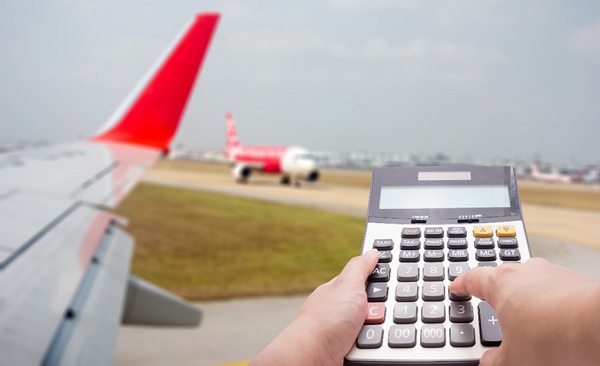
Airline Cash Forecasting Methods
The following are the different types of forecasting methods −
- Casual Forecasting − It is derived from analyzing the statistical relationship between dependent variable against independent variable. For example, analyzing trends.
- Trend Forecasting − The changes of dependent variable are judged with respect to time. This helps in anticipating time-related changes.
- Cyclical Variations − These are the changes in cash flow due to business cycles.
- Seasonal Variations − These are the changes in cash flow due to a specific time period in the year.
- Irregular Variations − These are the changes in cash flow due to erratic events such as strikes, wars, price wars, bankruptcies, or any other disturbance.
Airline Finance − Overview
The following are the four basic factors in airline finance management −
- Income Statement − It is a report that shows business managers and investors whether the airline made or lost money during the specific period.
- Cash Flow Statement − It provides information on cash receipts and payments, and the net change in cash due to operating, investing, and financing activities of an airline during the period.
- Stockholders’ Equity Statement − It is a record of the current equity stake held by the airline’s investors.
- Balance Sheet − It gives an idea about the financial position of the airline at a given point of time. It reflects what the airline owns as well as how much it owes.
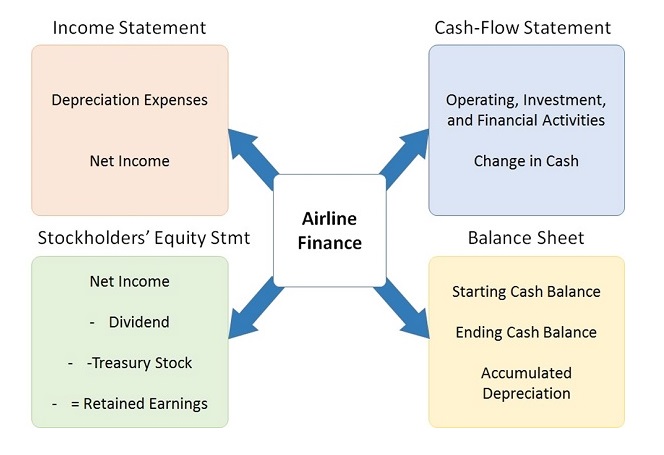
Fuel and Currency Hedging
Airlines are extremely exposed to the changes in aviation fuel or jet fuel costs. A slightest change in the fuel prices can affect the airline business finance and operations. To deal with fuel price changes, the airlines use a tool named Fuel Hedging.
What is Fuel Hedging?
It is a contract that the airlines use to protect themselves from the changes and rise in fuel rates. The cost of fuel hedging depends on the forecasted price of fuel. The airlines enter into hedging contracts with fuel companies to establish a fixed price of the fuel. In future, if the fuel price increases than their contracted price, the airline is forced to pay the contracted price. If the price of fuel decreases than the current fuel price, then the airline receives the price difference from the fuel company.
Who provides fuel hedging service?
The fuel management companies, oil companies, and financial service companies provide fuel hedging service to the airlines. For example, World Fuel Service, British Petroleum, Morgan Stanley, and BNP Paribas.
Airline Revenues
With fierce competition in the aviation industry, the airlines come up with ideas of generating revenues in various ways. They study the customers and their needs, the competitors, reduce the airfare to attract new customers and keep the existing ones loyal. They also generate revenue from ancillary products and services.
Airline Taxes and Fees
Apart from the ticket price, they are the charges for fuel surcharge and service tax.
À la Carte Pricing Policy
It is a new pricing approach to let the customer choose the ancillary product or service and pay for it. For example, buying meals, snacks, and drinks on board that was traditionally part of the ticket. Also, the Low Cost Airlines offer their customer priority boarding or to select the seat of their choice and pay for it.
Add-on Services for Travel
The ancillary services such as pick-up and drop-off services to and fro from the customer’s residence and ticket bookings for special events at destination are offered as a part of ticket booking.
On-board Sale
It means the sale of duty-free items such as jewelry, liquor, tobacco, electronic gadgets, and perfumes. The airlines have come up with a wide range of electronic items, kitchen items, travel items, and gift items for sale on board. It is also extended to discount cards, credit cards, and direct marketing catalogues.
Advertising Sales
Conventionally, airlines only advertised themselves through their magazines distributed in-flight. Now, through their own airline websites they generate considerable opportunities for advertising revenue. The website is a gateway to reach the potential air travelers via hotels, car-rental companies, and travel-insurance providers where they look for travel options.
Airline - Route Planning
Airline Route Planning is nothing but planning on the proposed route for flights. It involves the calculation of amount of fuel required for an aircraft to travel from the original airport to the destination airport. The route planning also involves −
- Plan of flight with adequate amount of fuel and most reasonable route.
- Compliance of flight with Air Traffic Control requirements.
The following are the various plans −
- Summary plan for Air Traffic Control (FAA/ICAO format).
- Summary plan for direct download into on-board flight management system.
- Detailed plan for the use by pilots.
For route planning, flight planning officers need to consider the weather conditions, weight of the flight at different stages, length of the journey, height at which it can be taken, and the rules set by ICAO for safe planning.
Flight Management System (FMS)
Flight Management System is an electronic system that navigates an aircraft according to the flight plan. Flight Plans are prepared by pilots or other professional dispatchers before departure and they are entered into Flight Management System. FMS also contains Navigation Database that contains all relevant information required to execute the flight plan.
What is Air Traffic Control Service?
The Air Traffic Control Service assists the airlines to ensure their safe and orderly operations in real time. The ATS is responsible for −
- Preventing aircraft collisions.
- Providing aid for the safe and efficient conduct of flights.
- Carry out and maintain an orderly flow of air traffic;
- Notify concerned organizations and assist in search and rescue operations of aircrafts.
Aviation Management - Airline Marketing
Airline is part of the travel and tourism service industry, where rivals compete to offer the best experience in spite of similar end products. Unlike organizations that sell tangible products such as cars, stationery, or food brands, the airlines sell elite experience to their customers. The experience that they provide to the customers is intangible as well as invisible.
Airline Marketing Environment
The airlines find out insights of the marketing environment using a powerful model of analysis called the PEST analysis.
PEST Analysis
The field of marketing comes up with a useful model for the study of an organization’s Marketing Environment. This model proposes that the factors should be categorized into Political, Economic, Social, and Technological (PEST).

This model turns up reliable for the airline industry to understand market growth or decline, business position, and direction for operations.
- Political Factors − Fear of terrorism, political instability in the country, deregulation of government policies.
- Economic Factors − Economic growth or instability in the country.
- Social Factors − Aging population, change in holidaying tastes, change in family structures, uncertain labor.
- Technological Factors − High-speed electronic devices, fuel-efficient aircrafts, Internet.
Knowing the Airline Customers
To market their service, the airlines works on understanding their customer’s psyche, demographics and needs.
Airline Customer Segmentation
The airline customers are divided into the following segments −
- Old Travelers − They are aged customers probably retired and go on holidays frequently.
- Business Travelers − They are frequent flyers and form a large segment.
- Budget Conscious Travelers − They look for the most inexpensive airline without knowing much about the different airline services.
- Loyal Travelers − They travel frequently and as they travel frequently with the same airline, the airline offers some benefits to them and also the miles.
- Urgent Travelers − They share a small market segment and do not fly frequently. They fly only for unexpected causes.

What do Customers Expect Before, During, and After the Flight?
Here are few considerations the customer thinks of before selecting an airline service −
- Timeliness in Service − Delays at baggage counters and in flight departure create a lasting negative impact on the passengers.
- Assurance of Reliable Service − The airline staff committed to service and highest customer satisfaction. The quality of service is always up.
- Convenience − Easy check-ins systems and ticket reservations.
- Attentiveness − The airline staff that recognizes needs and works a step ahead to meet them constructively.
- Comfort − Adequate knee and leg room around seat.
- Meals − Free in-flight meals of satisfactory quality.
- Safety and Security − Emphasis on safety and security.
Customer Psyche and Airline Marketing
For airline businesses, it is very vital to retain the customers, increase their loyalty, and facilitating the spread of positive word of mouth. The airline marketing staff reads the apparent needs and true needs of the customer. The airlines can do this by providing them the best experience of flying with them as the customers rely mostly on their own experience with the airline. If the airline is successful in meeting its customers’ needs, then it makes a notable name and money for itself.
Airline Marketing on Social Media
All the airlines around the world understand that today’s customers are tuned to Internet almost all the time hence, the airlines tend to make a striking presence on Internet. The airlines are leveraging ways to reach their customers using social media too.
For example, Cathay Pacific Airways has created a Facebook page to display deals, promotions, limited-period offers, and videos about the airline. Qatar Airways has a strong presence on Twitter with sharing news, events, upselling, and conveying the information on how the company is doing.
Turkish Airlines marketing policy depends on using hashtags for building relevance and authenticity, whereas Emirates is using Instagram.
Maintaining presence on the social media is a 24x7 work for which the airlines hire people, who know business strategies, write powerful content, and have the knowhow of brand positioning.

The airlines use Meme Jacking, the concept that spreads from person to person via Internet. It is an effective way to create a buzz around the brand.
The airlines also create webpages and videos based on the customers’ location and culture. The videos go viral and work without bringing out the customers from their comfort zone.
Airline Alliances
An alliance necessarily means an agreement between the airlines to work in cooperation substantially.
Why Airlines Form Alliances?
Working in alliances has benefits for both the airline and also the travelers.
Benefits of Alliance for Airline- Reduction in maintenance cost.
- Reduction in operating staff.
- Reduction in investment and procurement costs.
- Lower ticket prices due to lowered operational costs.
- More options for departure times to choose from.
- More destination options.
- Shorter travel time.
- Access to a large range of airport lounges shared with alliance members.
- Faster mileage rewards in single account on several different carriers.
There are three major airline alliances −
- Star Alliance (founded in 1997, 27 member airlines)
- Oneworld (founded in 1999, 15 member airlines)
- SkyTeam (founded in 2000, 20 member airlines
Air India is a member of Star Alliance.
Airline Loyalty Marketing
Many companies around the world earn more than 75% business from their loyal customer base of about 20%.
What is Airline Loyalty Marketing?
It is a business practice of the airlines to build trust among frequent customers by rewarding them so that they conduct business with the company continually. Loyalty marketing motivates the customers to remain loyal to the business by adopting loyalty programs.
For example, the customers are given an electronic account with the airline where the airline can deposit frequent flyer miles which can be redeemed for the next trip.
For Which Airline Customers Loyalty Marketing Works?
Loyalty marketing works with the customers who need to fly frequently or who choose the business with a particular airline because it successfully satisfies customer requirements uninterruptedly.
Aviation Management - Airport
An airport is a large organized and maintained area of land where airlines operate and park their aircrafts. Airport facilitates the aircrafts to take-off and land. The airlines can work smoothly when airports provide ample parking place, Air Traffic Service, and other ancillary facilities.
Types of Airports
According to AAI, the airports are divided into the following types −
- International Hubs − These airports have world class facilities. They include convenient connections for international and domestic passengers, ancillary facilities such as hotels, shopping areas, conferencing and entertainment facilities, and aircraft-maintenance bases. At present, there are International Hubs at Delhi and Mumbai.
- Regional Hubs − They operate regional airlines using small aircrafts to provide airconnection in the interiors of the country. Regional hubs act as operational bases for regional airlines. They are capable of handling limited international traffic.
- Individual Airports − Their status is reviewed at intervals of five years.
Airport Operations
Here is a list of some common operations that are carried out in an airport −
- Airport Security Operations − They are related to handling all security-related activities. Airport police and security staff work to avoid any mishap at the airport.
- Airport Maintenance Operations − They involve fixing or maintaining Airport infrastructure, facilities, and equipment. It involves renewing or repairing any part of the infrastructure, and repairing any automatic equipment used at the airport.
- Airport Public Relations − These operations are about community affairs.
- Commercial Handling and Development Operations − They are related to managing property licensing, leases, and other issues.
- Aircraft Rescue Operations − They are aircraft/airport accidents related operations.
- Fire Fighting Operations − They involve handling the accidents taken place due to fire.
Organizational Structure of an Airport
The following illustration shows a typical organizational structure of airports in general −
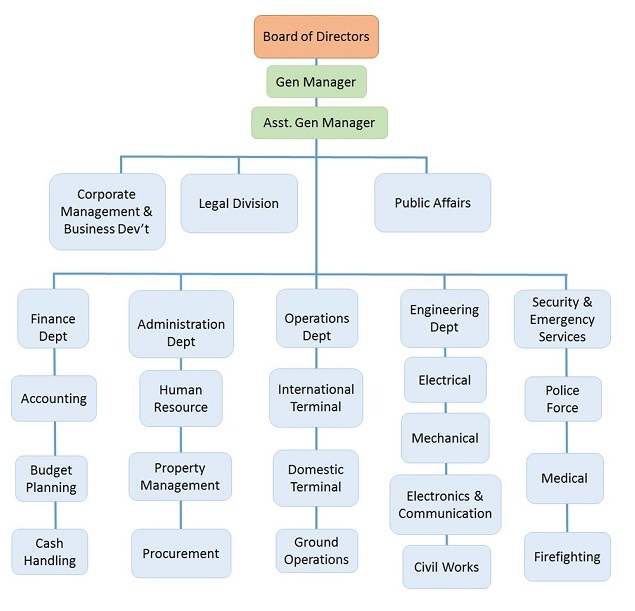
Airport - General Layout
An airport is mainly divided into two areas −
- Airside Area
- Landside Area
Airside Area
It is the area beyond landside area inside the airport. It includes runways, taxiways, and ramps.
- Runway − An area where aircraft takes off and lands. It is made of soft grass, asphalt, or concrete. It has white markings, which help the pilot during take-off and landing. It also has lamps on the sides to guide the pilot during night. The vehicles other than the aircrafts are strictly prohibited to enter this area of the airport.
- Ramp − Also called Apron, this area is used for parking the aircrafts. It can be accessed for boarding and alighting the aircraft. The airline staff or ground duty staff can access this area.
- Taxiway − It is a path on the airport that connects the ramp to the runway.
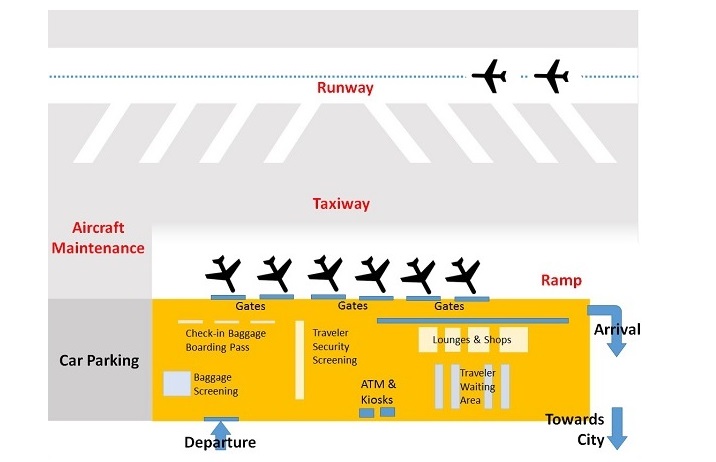
Landside Area
It is the area in the airport terminal and the area towards city. It has access to the city roads and it contains parking area as well as public transport area.
- Terminal − It is a part of airport building that where travelers come to board their flight or arrive from a flight. There are security checking, baggage checking, amenities, and waiting areas at the terminal.
- Car Parking − This area is outside but adjacent to the terminal where vehicles can be parked on chargeable basis.
Most of the airports around the world are owned by local, regional, or national government bodies. According to the Aircraft Rules, 1937, the airports other than government airports are permitted to be owned by Indian citizens, or Indian companies or corporations registered and having their principal place of business as India. In India, some airports are owned by the state governments, private companies, or even individual citizens.
Airport - Planning and Development
It involves planning, designing, and construction of terminals, runways, and other ancillary facilities for airlines to operate. Developing an airport requires huge amount of capital and anticipation of future growth of airlines and passengers. AAI is responsible for the development of airports in India.
Airport Designing
Airport projects are involved with many considerations and issues hence they are highly collaborative. Designing of airport is taken up by architectural firms. The architects work in collaboration with civil engineers to come up with the Airport Layout Plans. The experts come up with master plans which is referred to for further developments.
Planning an Airport
To plan an airport, the AAI is concerned for three approvals −
- Technical Approvals
- Review and approve Airport Layout Plan (ALP).
- Review and acceptance of forecast.
- Airspace and procedure changes.
- Land acquisition.
- Financial Approvals
- Funding for the airport is approved once the project gets clearance for safety, security, capacity, and airport access systems.
- Environmental Approvals
- Review and assess environmental issues.
- Find out solutions to address the environmental problems.
Airport planning is vital to understand problems and potential environmental issues. Out of the reactive and proactive planning methods, an appropriate planning method is selected depending upon the requirement.
Airport Development
It includes the development of the land to build the terminals and base, and building the infrastructure for the ancillary facilities. All the infrastructural development is done in accordance with the ICOA standards.
Airport − Terminal Planning
The following criteria need to be considered while planning and designing a terminal −
- Passenger flow and traffic peaking.
- Minimum walking distance.
- Level of service for passengers and sophistication.
- Performance standards.
- Area for Retailers: Duty free shops, food joints, and spas.
- Area for Facility points such as Restrooms, ATM machines, and kiosks.
- Easy access to retail area and facility points.
- Compatibility of facilities with aircraft characteristics.
- Ability to handle changes in technology and automation.
- Expandability for future growth.
- Area and processing time for checking-in, immigration/customs clearance, baggage security screening, and baggage delivery.
Airport − Terminal Configurations
The following configurations are adapted while designing the airport terminals −
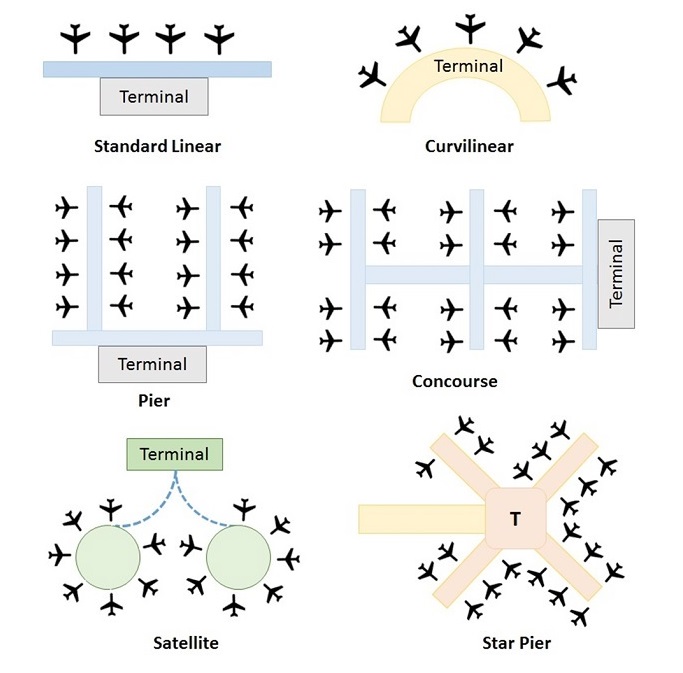
Examples of Airport Layouts
The following table provides a few examples of airports designed on the basis of the given layouts −
| Layout | Airport |
|---|---|
| Standard Linear | Detroit Métropolitain (DTW) |
| Curvilinear | Munich (MUC) |
| Pier | Amsterdam (AMS), Chitose Airport Japan (CTS), Los Angeles (LAX). |
| Concourse | Atlanta International Airport (ATL), Al Maktoum International Airport Dubai (DWC), O’Hare International Airport Chicago (ORD) |
| Star Pier | Geneva Airport Switzerland (GVA), Orlando International Airport, Florida (MCO). |
Airport - Financial Management
Airport budgets are prepared for one fiscal year. The budget planning experts consider basic operating expenses and revenues made for the period. The amount of expenses and revenue generated depends upon the size of the airport in terms of operations and the number of services airport provides. Let us see more about how airport financial management takes place.
Airport Funding
Developing and maintaining an airport needs a large amount of funds. The principle sources of this capital include −
- Government grants.
- International organization loans that are required to be repaid in the same foreign currency.
- Commercial loans from national financial institutions, which are usually available at highest interest rates.
- Equity or bonds from commercial capital market including private investors, and investments banks.
- Extension of credit from contractors and suppliers.
- Foreign governments invest in airport development for under-developed nations.
- Retained earnings.
Airport Income Sources
Airports need to generate sufficient revenue to pay for their operating costs such as manpower salaries, maintenance, electricity, and more that are aligned to actual operating of the airport.
Airports derive their revenue from rents, charges and fees imposed upon airlines, various concessionaires, such as car rental companies, restaurants, newsstands, taxi and van services, catering and baggage services, fuel provision, and parking.
Revenue from Airport Taxes and Fees
This revenue is generated by applying the following charges −
- Passenger Service Fees − Against security and facilities at airports.
- Airline Rents − Airlines pay rents for the space they occupy at ticket counters, gates, baggage counters, gates, baggage handling, maintenance, and catering facilities. They also pay takeoff and landing fees, parking fees, and fuel fees.
- Development Fees − Against infrastructure development at international airports.
- Government Subsidies − They are required to seal the gap between budgeted revenue and operating expenses.
Revenue from Other Airport Incomes
- Fuel Sale − Selling fuel for the aircrafts which halt at the airport for refilling on longhaul routes.
- Late Fees on Leases − Many airports charge late fees on leases.
- Renting out − Several airports rent out non-used pavements or runways for the purpose of taxiway driving courses and for filming commercials.
Pricing of Airport Services and Facilities
There are no set guidelines on how the airport operation managers must determine the rates of charges for the use of airport building, facilities, and equipment. The reason behind this is, the airports are not commercial entities; but public funded facility.

Still, the common method the airport managers employ is to assess the prices charged by the neighboring airports for offering services and facilities.
Sale of Airport
If an airport is not generating revenue for its overall operating costs, it cannot survive in the market for long as it gets difficult. The most generic reasons of selling an airport are −
- It is constantly failing to generate self-sufficient revenue.
- The revenue is insufficient to repay the loans taken at the time of its development.
- It is underused and in such case the cost of maintenance is also high.
- In some cases, the airport owner decides to generate the cash required for other infrastructure projects.
Reasons of Airport Privatization
Governments of developed countries view airports as assets as well as business. Their government sells all or a partial interest in existing airports or airport authorities.
Developing countries lack the resources for airport development, hence they rely on private capital and expertise. Their governments tie up with private sector organizations to finance and develop new terminals or airports. Private sector businesses can manage airports and also business in better ways.
Airport sales have taken place in four countries, and another seven have announced plans to sell their major airports. Franchises for new airport capacity projects are under way in 17 countries and under study in 14 others.
Airport Privatization Modes
There are three major privatization modes −
- Contract management
- Long-term lease
- Sale
Benefits of Airport Privatization
The following are the most common benefits of airport privatization −
- Increased functionality and efficiency
- Increased revenues
- Increased passenger amenities
- Reduction in risk of unwise investment
Aviation - Safety Management
Aviation risks and threats are a part of the daily operations of the aviation industry. They can put passengers to face time delays, price hikes, uncertainty or even the loss of life. Though it uses radars, which spot intrusion into the controlled airspace and other navigational aids, the aircrafts face threats of losing its path. Today, though a large number of instruments aid aviation operations accurately in real time, aviation business is prone to hazards, risk, and threats.
Since numerous passengers travel by air frequently, there are objections related to risks, vulnerabilities, and threats.
Risks in Aviation
It is a potential loss or damage of property, information or lives (=assets) that can happen due to a threat. Literally, there is a risk if the assets, vulnerabilities, and threats are present together.
Common Aviation Risks
Aviation risks include operational, strategic, compliance, or financial risks that than put the assets into problem. There can be several types of risks for aircraft as well as airport −
- Bad weather conditions for a flying aircraft
- Aircraft about to run out of fuel while in flight
- A person in the aircraft or airport needs medical aid critically
- Failure of electrical, electronics, or mechanical component
- Pilot’s mistake
- Bird-strike at the time of aircraft movement
- An inexperienced employee or unknown person at the airport
- Unscreened passengers or their articles allowed to board the aircraft
- Repayment of loan
The risks can be seen as most forgivable to most intolerable.
Risk assessment is performed to uncover the loopholes in the systems and take corrective actions. Risk analysis is done to find out the particular cause of the accident or incident and reduce the likelihood of further risks.

Vulnerability in Aviation
Vulnerability is a weakness or a loophole in the security system. A threat can take undue advantage of a vulnerability to breach the security and destroy assets.
Common Aviation Vulnerabilities
The following can be the different vulnerabilities that the aviation industry undergoes −
- Access to airside area of the airport to non-traveler/non-staff people
- Poor screening methods for passengers and baggage
- Poor aircraft or airport maintenance
- Overcrowding near adjacent gates at the time of departure
- Poor security in handling information regarding flight plan
Threats in Aviation
A threat is a particular source of attack. Can someone forget the most notorious and perilous 9/11 attack where four airliners were hijacked to carry out a suicidal attack on World Trade Center and Pentagon. On December 24, 1999, Air India IC 814 with 178 passengers and 11 crew members was hijacked by terrorists and taken to Kandahar, under the then Taliban control. Today the terror methods have potentially increased with sophistication in destroying.
There are many such incidents when the aircrafts are hijacked by terrorists or extremists and this often leads to the loss of assets. These threats are mostly intentional. In some rare cases, mentally unstable people have been found to be the cause of such incidents.
Common Aviation Threats
The following can be the common aviation threats −
- Unattended or unclaimed baggage found at airport.
- A person carrying weapon without declaration.
- A person not cooperating with the security staff.
- A person carrying sharp objects with him.
- A call from an unknown person for destruction.
- A person with suspicious gestures and appearance.
Safety and Security in Aviation
The airport security systems and staff together work towards the safety of the airport, the aircraft, and also the safety of the passengers. To manage the airport as well as the aircraft security, the following measures are employed −
- Aircraft and airport employees are trained on security and safety issues, as well as crisis handling procedures.
- Aircrafts are equipped with emergency exit way and procedures for passengers.
- Airport areas are monitored by Closed Circuit TV cameras.
- A dedicated team of trained police force is employed for airport and aircraft safety.
- The security staff takes the help of sniffer dogs to detect any unclaimed object lying around the airport.
- The airports are equipped with fire-fighting alarm and fire-extinguishing systems.
- Sensitive airside areas in airports, such as ramps and operational spaces, are restricted from the general public.
- Every traveler who arrives at the airport needs to enter into the airport only from the Departure entry. The traveler can go in further only after showing a valid journey ticket, an identity proof, and a passport if required.
- Non-passengers need to obtain a gate pass and face security checking to enter the secure area of the airport.
- Traveler check-in baggage and handbags are strictly screened through X-ray machines.
- Travelers are screened by metal detectors before they board. But they can be subjected to later screening if required.
- Travelers are not permitted to enter the cockpit area of the aircraft.
- The food joints at the airport use containers and glasses made of plastic instead of those made of glass as they can be used as weapons.
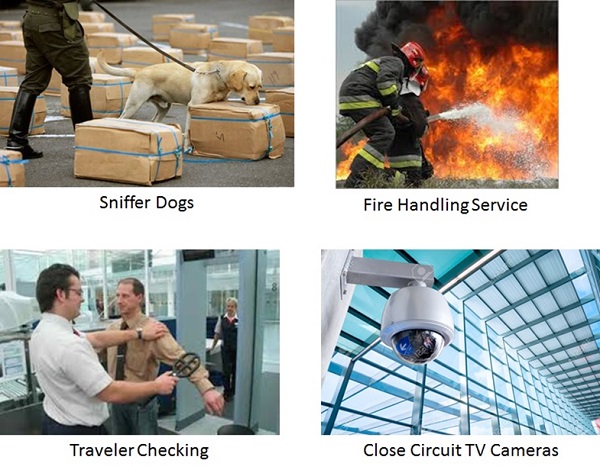
Dulles International Airport at Washington uses Fiber Optic Perimeter Intrusion Detection System that enables the airport security to locate and detect any intrusion on the airport perimeter, ensuring real-time, immediate intrusion notification. This further enables the security staff to carry out necessary security procedures.
A recent X-Ray technology is helping the airport safety and security staff to detect weapons and chemicals on passengers. This system has sensors to detect volatile compounds given off from explosives using gas chromatography.
Object Prohibited into Airport / Aircraft
Travelers are prohibited from carrying any personal stuff that can be harmful in the airport premises or in the aircraft. These objects are −
- Personal Stuff − Razors, scissors, manicure kits, knives, ropes or strings
- Liquids − Personal water-bottle, flammable or non-flammable liquids, fuels, gels
- Explosives − Gas cans, fireworks or fire-extinguishers
- Food Items − Jellies, soups, syrups, dips, salad dressings, vinegar, sauces, and alcohol
- Tools − Crowbars, catapult, hammer, saw, drills and drill bits, screw-drivers, wrenches, pliers, metal or plastic wires
- Sports Equipment − Hockey sticks, cricket bats, bows and arrows
Contingency Planning
The Air Navigation Service Provider (ANSP) needs to set up contingency strategies to handle future mishaps that may arise due to various risks and threats.
The contingency strategies are of two types −
- Alternate airspace strategies
- Alternate location strategies
Contingency Planning involves −
- Finding out if there is an already existing plan to manage the consequences of the incidents or accidents.
- Inventory of the units/services/functions of an Air Navigation Service Provider (ANSP).
- Identifying realistic events which increase the likelihood of the mishaps and lead to the loss of assets.
- Developing or changing contingency measures that meet safety and security requirements.
- Developing a plan for Contingency Assessment to ensure that contingency requirements are met.
- Developing plan and procedures to resume the normal operations.
Birds, Wildlife, and Snow Control
Collision with birds is one of the major challenges for aircraft safety. Aircrafts can sometimes damage themselves after colliding with birds. To avoid such mishaps, the airports need to install Airport Bird Control System, which is specifically created for repelling birds and other wandering animals away from airports and runways.
Some airports use Bird Aversion Liquid or Gas, which upon spraying creates an invisible barrier between birds and aircraft. This spray irritates birds' sensory system, which is harmless for their life but keeps them from flying near airport.
Some electronic bird repellent systems also have high-output amplifiers with multiple speakers installed in tower design. These systems are weatherproof and are capable of repelling birds up to 30 acres with a sound output around 125 DB.
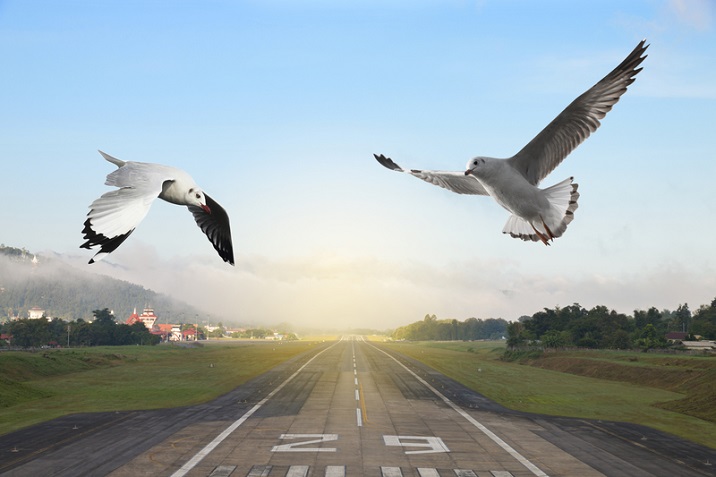
It is not just the combination of a bird and an aircraft flying into each other that is dreadful. An animal on the runway also can cause a great hazard as flipping an aircraft while taking off or landing. There are chances of wild animals entering the runway if it is not properly secured. To deter animals’ entry, the airports are surrounded with partially buried fencing.
Aviation - Disaster Management
If the prevention of accidents or incidents fails and some critical event still occurs, then the disaster management team of the organization must try to limit the damage done to stakeholders, property, the environment, and the organization itself by responding to the critical situation.

The initial investigation reports might be vague till the facts are uncovered completely. The crisis management team needs to get the correct report and take intelligent as well as immediate actions to handle the disaster. If the loss is not handled appropriately, the media accuses the organization for being irresponsible.
After handling the initial phase with immediate action, the organization then enters into the resuming or restoring phase. It rebuilds its own reputation, refines the public perception, and recovers the loss over property.
Accident Investigation
Accidents and incidents happen around the airports or while the aircraft is in transit. There can be numerous reasons such as runway incursion or excursion, bad weather, failure of a functional system component, loss of ground communication, and a lot more.

The authorities conduct investigation according to the international standards by visiting the site and collecting vital information from the site as well as by retrieving the black box of the aircraft. The sole purpose of the investigation is to find out the cause and to avoid repetition of similar incident or accident in future.
An NGO named Aircraft Crashes Record Office (ACRO) at Geneva compiles statistics on aviation accidents. The International Civil Aviation Organization (ICAO) is primarily focused on preventing accidents. As such there are various organizations from each country to investigate aviation related accidents.
In India, the Directorate General of Civil Aviation (DGCA) investigated incidents Until May 30, 2012. Since then, the Aircraft Accident Investigation Bureau (AAIB) has taken over the investigation responsibilities. In USA, National Transportation Safety Board (NTSB) officials gather the evidence from the crash site and assess the cause. The organization also investigates incidents involving US-registered aircraft, in collaboration with local investigation authorities when there is a significant loss of American asset.
Aviation Management - International Air Law
Aviation Law is one of the specialty field in Studies of Law. Air Law is a general viewpoint that covers the special characteristics and demands of aviation field. There is no governing body with the right to frame the air laws governing all states in the legal sense or there is not any international law. But the phrase Air Law is used to describe a system of implicit and explicit agreements that the nations together. These agreements are known as conventions. There are numerous conventions such as Chicago, Rome, Tokyo, Geneva, and few more. Let us discuss more about the aviation law.
What is Air Law?
It is a branch of law that is concerned with air transport operations, and all the associated legal and business concerns. This is a series of rules that governs the use of airspace for aviation, and its benefits for the general public and the nations of the world.
The first attempt to set the air law was made around 1910, when German air balloons repeatedly trespassed over French territory. The French government wanted both the governments to come together to form an agreement to resolve the problem. The Paris Conference of 1910 was in favor of the sovereignty of states in the space above their territories.
It started developing further when after the World War I, the first scheduled flight from Paris to London took its first flight in 1909.
Public International Air Law: Chicago Convention
A Convention on International Civil Aviation was signed at Chicago on 7th December, 1944. It established specific principles in order to develop international civil aviation in a safe and orderly manner. It also ensures that international air transport services are established on the basis of fair opportunity for participating countries.
The convention formed the International Civil Aviation Organization (ICAO), the Canada-based agency of the United Nations. It sets the principles of international air navigation and works to −
- Ensure a well-ordered growth of international civil aviation throughout the world.
- Encourage aircraft design and operation for peaceful and constructive purposes.
- Promote the development of airways, airports, and air navigation facilities for international civil aviation.
- Meet the safety, regularity, efficiency, and economical air transport needs of the people around the world.
- Prevent unplanned economic decisions and in turn waste.
- Ensure that each Contracting State has an opportunity to operate international airlines.
- Encourage flight safety in international air transport.
- Foster the development of all aspects of international civil aviation.
Air Law in European Union
The laws are regarding the following −
- Sovereignty − It is the right of a state to impose its national law on users of its airspace.
- Territory − It is the airspace over and within the territorial borders of a state. Territorial airspace has no vertical limit. For the states with sea boundaries, territorial airspace extends beyond the land. This limit is internationally agreed limit of the territorial waters.
International Air Laws
The three International Air Laws are as follows −
Public International Law
It refers to the process which binds the states and international organizations to agreements with respect to their aviation activities. The activities may be among various problems of political, technical, economical, financial, social or legal nature. For example, the Chicago Convention, the Geneva Convention, and some international conventions.
Private International Law
It is the series of rules pertaining to the relations between private persons involved in the operation and the use of aircraft. It applies to the travelers and airline staff. For example, the Tokyo Convention frames the prohibition of unlawful acts committed on the aircraft.
Supranational Law
It is a law that a higher body can impose with legal force on one or more states. For example, EU air laws.
IOSA and its Importance
The IATA Operational Safety Audit (IOSA) is an internationally recognized and accepted system that audits and certifies operational management and control systems in the airlines.
IATA formed this certifying evaluation body in 2003. It conducts airline audits according to the aviation laws consistently.
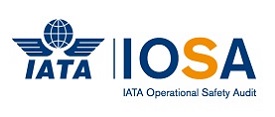
The airlines which have no IOSA certification probably either failed in the auditing or they did not participate in auditing at all. Carrying out IOSA audit makes an airline more reliable but the cost of audit is high. Mostly only international airlines participate in the audit as they can bear the cost of audit and implement the changes suggested.
The crash-rate, which is measured per specific number of flights, is three times less in the airlines which took IOSA audit than the ones which did not.
International Civil Aviation Organization (ICAO)
ICAO consists of an Assembly of representatives from the contracting states, a Council of governing bodies out of various subordinate bodies, and a Secretariat. The chief officers are the President of the Council and the Secretary General. ICAO conducts meeting every three years to discuss about the work and to set future policies.
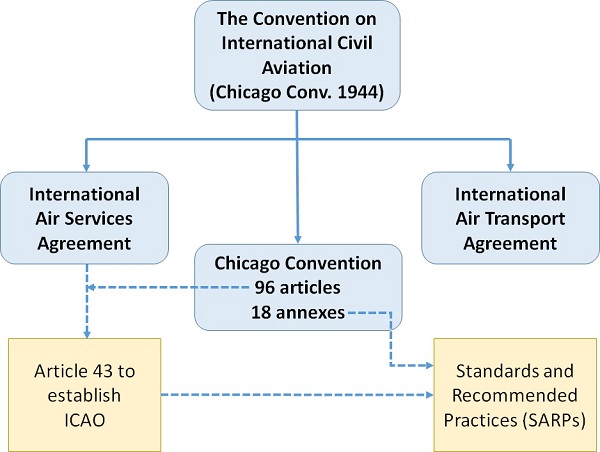
The suggestions, standards, and recommendations are amended by the convention. ICAO identifies nine separate geographical regions to plan the provision of air navigation facilities and on-ground services the aircrafts require for flying in these regions.
Freedoms of the Air
There are five different freedoms of the air. The first two are technical freedoms followed by three commercial freedoms −
- First Freedom − The right of aircraft from State A to overfly State B without landing.
- Second Freedom − The right of aircraft from State A to land in State B for technical reasons.
- Third Freedom − The right of aircraft from State A to accept paying traffic from State A and put it down in State B.
- Fourth Freedom − The right of aircraft from State A to pick up paying traffic in State B and put it down in State A.
- Fifth Freedom − The right of aircraft from State A to take paying traffic from State B to State C.
Aviation Management - Concerns in Aviation
Any public transport relies on planetary resources, which are finite. Aviation cannot assume a long term sustainability as it also relies on those finite resources such as fuel.
Latest technology is aiding today’s aircrafts to fly efficiently over long distances. The demand of air transport around the world is increasing because of the improvement in the lifestyle. In the bargain, the society and the nature needs to pay the price, accept some drawbacks such as noise, pollution, and use of resources.
The following environmental concerns are important when it comes to aviation −
Social Concerns of Aviation
Noise is the prime environmental challenge for aviation. Though it does not leave a permanent impact on the environment, people living near the airports are subjected to communication interference, insomnia, and deafness. The students show problems in learning acquisition and the patients in the nearby hospitals show have to face physiological impacts because of the noise.
It is observed that the aircraft flying at least 10,000ft high above the ground does not produce significant noise.
Environmental Concerns of Aviation
Aircraft engines operate by combusting fuel to a great extent. Due to the emission produced by fuel combustion, the quality of air around few kilometers of the airport gets affected significantly. It is about 3km up at the time of departure and 6km down at the time of landing the air quality is hampered. In addition, the baggage and food carts moving on the taxiway produce smoke if not maintained well.
Contribution of Aviation to Climate Change
Climate change is the alteration in average weather conditions that a given region undergoes. It involves consideration of various factors such as temperature, storm frequency, winds, and rains. Aircrafts emit greenhouse gases such as Carbon Dioxide (CO2). They also emit water vapor, which traps chemically active gases that change the natural greenhouse gases Ozone (O3) and Methane (CH4).
Aviation Management - Careers in Aviation
In this chapter, we will discuss the career opportunities in the aviation industry.
Airline Careers
There are various positions in airline.
| Position | Requirement |
|---|---|
| Assembler/Installer | Diploma |
| Aviation Attorney | Law Degree |
| Aviation Medical Examiner | Medical Degree |
| Baggage Handler | Diploma |
| Cabin Maintenance Mechanic | Diploma / Degree + Technical Training |
| Ground Attendant | Diploma / Degree preferred |
| Information Systems Specialist | IT Degree |
| Ramp Service Personnel | Diploma / Degree preferred + Training |
| Cabin Crew | Diploma / Degree preferred + Training |
Pilots
Here are some typical pilot positions in aviation −
| Position | Requirement |
|---|---|
| Corporate Pilot |
|
| Military Pilot | |
| Regional Pilot | |
| National/International Pilot |
Airport Careers
There are a variety of positions pertaining to airport operations −
| Position | Requirement |
|---|---|
| Accident Investigator | Degree + Training |
| Administrative Assistant | Diploma / Degree preferred |
| Air Freight / Cargo Agent | Diploma / Degree preferred + Training in shipping |
| Airframe and Powerplant Inspector | Diploma + Technical Training + A&P License |
| Airframe or Powerplant Mechanic | Diploma + Technical Training + A&P License |
| Airport Manager | Degree in airport management / BBA / MBA |
| Avionics Technician/Specialist | Diploma / Degree preferred + Technical Training |
| Cargo Handlers | Diploma in Cargo Management |
| Concession Worker | Diploma |
| Customs Agent | Degree + Training |
| Flight Instructor | Diploma / Degree preferred |
| Food Preparation Specialist | Diploma / Degree preferred + Health Certification |
| Information Systems Specialist | College Degree in IT field |
| Lineperson/fuel handler | Diploma / Degree preferred |
| Marketing / Public Relations | BBA / MBA (Marketing) |
| Operations Supervisor | College Degree |
| Ramp Service Personnel | Diploma / Degree + Special Training |
| Safety Inspector | Engineering Degree + Training in Aviation Mechanism |
| Security Officer | Diploma / Degree preferred + Special Training |
Characteristics of Aviation Employees
The following are the key skills the aviation employers look for in their prospective employees −
- Work Competency − The prospective employee needs to be equipped with the related education in the field of aviation and should be able to demonstrate the procedures if required at the time of interview.
- Work Initiative − If there is no work load for some time, the employee must take initiative to do other allied tasks enthusiastically, which aid the business operations. They must invest the time in learning a new skill beneficial to the business.
- Mindset of High Ethical Values − The employees must possess ethics such as loyalty towards work and business, and trustworthiness. The employees need to guard the airline business and its reputation by working ethically.
- Excellent Communication Skills − The employees need good command over communication skills as they might have to deal with customers, colleagues, superiors, and other persons while on duty. They must use polite and clear language while communicating with the customers.
- Team Playing Nature − Since aviation industry is also a business of coordinated efforts, it needs a coherent team to execute a flight successfully and safely. The leading team members must accommodate the younger ones to groom and the younger ones must follow and learn from the seniors. Overall, the teamwork should reflect.
- Soft Skills Equipment − The employee must be assertive, courteous, optimistic, and hardworking. The employee must be able to handle anger and control one’s temperament.
- Critical Decision Making − There can be times when the employees need to handle critical situation without losing control on oneself and saving assets from a mishap. For such times, the employees’ readiness to think critically and bravery helps.
Emerging Trends in Aviation
The aviation field involves a network of aircraft manufacturers, airline businesses, airport management, government, travel agents, bank partners, and insurance companies.
The following trends are emerging in the aviation industry −
- State of the art automation and ever-improving technology aids smooth aviation operations. There are new aircrafts with high fuel-efficiency and other devices coming up to aid airline management and airport management.
- The customer expectations have increased. Since airlines and airports provide experience as an intangible product, they need to be always tuned with upcoming market changes and maintain customer loyalty towards themselves.
- Upgrading the aircrafts (the hard product) is still a challenge because of the expenses for purchasing them. The paybacks can be extremely positive or negative down the future timeline. Today most of the airlines are focusing on maintaining their aircrafts and enhancing the customer experience (the soft product) right from booking their tickets up to their arrival at the destination.
- Airlines are focusing also on the cost controls through refining organizational structure, model of operations, and work practices.
- The Low Cost Carriers’ growth rates continues to be above-average in the aviation industry. But there are challenges to face such as customer expectations, especially in full-service airline markets.
Most of the regional airlines prefer to lease the aircrafts and support system to the international airlines.

Comments
Post a Comment